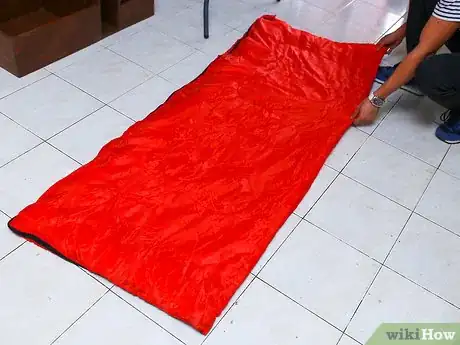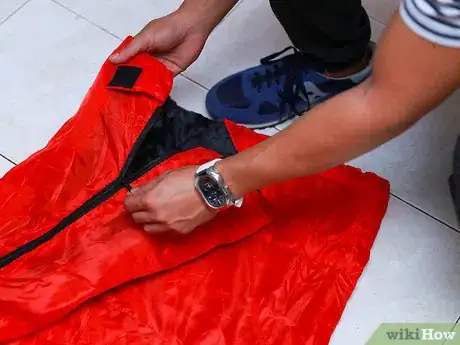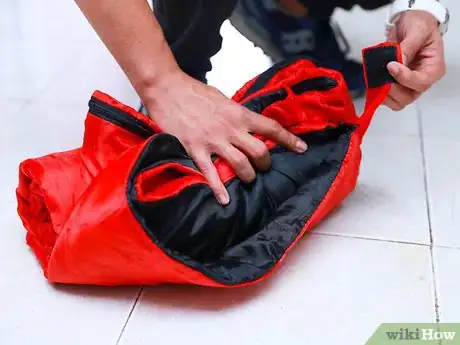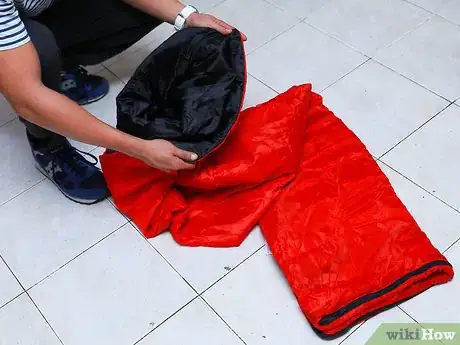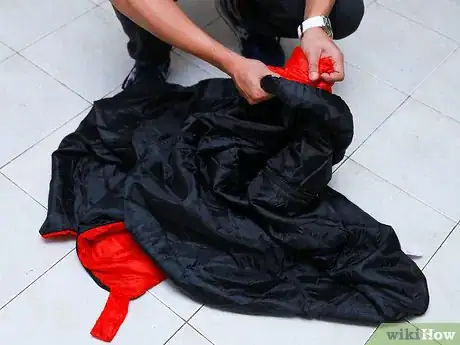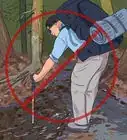This article was co-authored by Josh Goldbach. Josh Goldbach is an Outdoor Education Expert and the Executive Director of Bold Earth Adventures. Bold Earth leads adventure travel camps for teenagers all over the world. With almost 15 years of experience, Josh specializes in outdoor adventure trips for teens both in the United States and internationally. Josh earned his B.A. in Psychology from Eckerd College in St. Petersburg, Florida. He’s also trained as a wilderness first responder, a Leave No Trace master educator, and a Level 5 Swiftwater rescue technician.
This article has been viewed 246,749 times.
Rolling a sleeping bag is an essential skill for any camper. Though bags come in a variety of shapes and storage options, rolling your sleeping bag is easy. Once you've determined how your bag should be rolled, getting it together is simple.
Steps
Rolling a Sleeping Bag
-
1Do not roll a bag if it comes with a stuff sack and space is no issues. Rolling a bag frequently can damage the insulation, making it less effective at keeping you warm. Most bags that come with a storage bag are actually meant to be stuffed into the bag loosely, not rolled. Check your owner's manual if you are unsure how to store your bag.
- If the bag came with straps, either separately or attached near the head, it is likely meant to be rolled. These straps are meant to keep the bag rolled up.
- If you need to save space, rolling your bag is the best way to compress it into its smallest shape. However, you should try to remove your bag from compression as soon as possible.[1]
-
2Lay the sleeping bag on a flat, dry surface. If possible, use your ground tarp of the floor of your tent to roll up the bag, as this will keep it clean and moisture from getting rolled into the bag, where mildew might grow.Advertisement
-
3Zip up the bag and push any large air pockets out through the head. Zip it up completely, as an unzipped bag makes it hard to roll evenly.[2] Smooth out the bag so that you get out as much air as possible, as air pockets will prevent an even, tight roll.
-
4Fold the sleeping bag in half lengthwise. Fold one side over so that it lines up with the zipper. Take some time to make sure the edges are lined up. They don't have to be perfect, but the closer you can get them the better.
-
5Start rolling upwards, firmly, from the feet. Use both hands to roll the bag up tightly, kneading it with your hands to push any air in the bag up and out the hole at the top for your head.[3]
-
6Sit on the bag with your knees to keep it tight. If you are having trouble getting the bag tight enough, crouch down and use your knees to keep the roll tight and push out air. Then roll up another 2–3 inches (5.1–7.6 cm), using your fingers to get the roll tight, and push some more air out with your knees.
-
7Use the attached straps to keep the bag rolled. Most sleeping bags that are meant to be rolled have straps that cinch around the rolled bag and then tighten, keeping it rolled up. You should have at lease two, and they should be positioned roughly 1/3 of the way from each edge of the rolled bag.[4]
- If you don't have straps, you can improvise one out of a belt, large rubber bands, or rope.
- If your bag came with a bag but no straps, store the sleeping bag in the appropriate carrying bag and close the top tightly.
-
8Keep the bag dry and free from water. If you are in the backcountry a wet sleeping bag isn't only uncomfortable, it can be dangerous. Water wicks heat away from your skin much faster than air, so a wet bag can lead to deadly cold temperatures if you aren't careful. Keep your bag in a waterproof bag, or improvise one out of garbage bags if you don't have one.[5]
Avoiding Common Issues
-
1Know that prolonged compression will make your bag less effective. Keeping your bag tightly stuffed or rolled for long periods of time will make it lose loft, which is what traps hot air to keep you warm.[6] While you want to roll your bag tightly to travel with, you should never store your bag compressed or jammed in a stuff-sack.
- Loosely roll your bag, or let it rest, lightly folded, when it is not in use.
-
2Turn wind or water resistant bags inside out. The layering on the outside of these bags is great at keeping air out when you need to stay warm, but it can keep air in when you need it to escape for packing. Turn these bags inside out, zip them up, and then roll them as normal.[7]
-
3Use a stuff-sack for tighter packing. These bags come with several straps and cinches that let you pull down on the top of the bag and get it even smaller. They are usually waterproof, and you can often get a large enough bag the lets you stuff several other items, like shirts or camping pillows, in with the bag.
- Always start packing by the tail if you use a stuff sack -- this allows the air in the bag to escape through the top.
-
4Air out your bag when you return from your trip. While you should never stuff your bag and store it fully compressed, good bag care requires brushing out any dirt, twigs, and leaves and letting the bag dry out completely when your trip is over. Mold and mildew will grow if your bag is allowed to be stored wet, and it is tough to remove once it grows. Let the bag rest outside on a dry day for several hours and brush out any debris.
- UV light can damage the sleeping bag fibers, so take care not to leave the bag in the sun all day.[8]
-
5Gently pull any leaking down feather back into the bag. A few loose pieces of down is not uncommon in new sleeping bags. Gently work the quills back into the bag, pulling from the back side whenever possible. The holes will close back up and the insulation should settle with time.[9]
Community Q&A
-
QuestionHow can I roll up a Kodiak sleeping bag?
 Community AnswerYou can always lay it out on the ground and tightly roll it up. If that doesn't work, you can just stuff it in the bag tail first.
Community AnswerYou can always lay it out on the ground and tightly roll it up. If that doesn't work, you can just stuff it in the bag tail first. -
QuestionHow can I make this method easier for young kids?
 Community AnswerI would give them a strip of fabric or paper to assist them in rolling up the sleeping bag. Have them start by just rolling up the paper, and then graduate to rolling up the sleeping bag.
Community AnswerI would give them a strip of fabric or paper to assist them in rolling up the sleeping bag. Have them start by just rolling up the paper, and then graduate to rolling up the sleeping bag. -
QuestionHow to put this sleeping bag in a small luggage having left more space
 Community AnswerDepending on whether the luggage area you have is wide or thin, either roll the bag up as is, or fold it in half width wise. Then tie it off tightly with string in the middle, and on both sides about 3 inches from the edge. If this doesn't work, it may be smart to get a new, thinner bag. They sell thinner bags that are just as warm as thick ones nowaday!
Community AnswerDepending on whether the luggage area you have is wide or thin, either roll the bag up as is, or fold it in half width wise. Then tie it off tightly with string in the middle, and on both sides about 3 inches from the edge. If this doesn't work, it may be smart to get a new, thinner bag. They sell thinner bags that are just as warm as thick ones nowaday!
References
- ↑ https://www.trails.com/how_1488_compress-sleeping-bag.html
- ↑ https://www.trails.com/how_741_fold-sleeping-bag.html
- ↑ http://equipped.outdoors.org/2012/04/how-to-stuff-sleeping-bag-three-simple.html
- ↑ https://www.trails.com/how_741_fold-sleeping-bag.html
- ↑ http://indefinitelywild.gizmodo.com/five-ways-to-sleep-outside-without-a-tent-1598690786
- ↑ http://www.rei.com/learn/expert-advice/caring-sleeping-bag.html
- ↑ http://equipped.outdoors.org/2012/04/how-to-stuff-sleeping-bag-three-simple.html
- ↑ http://www.rei.com/learn/expert-advice/caring-sleeping-bag.html
- ↑ http://www.rei.com/learn/expert-advice/caring-sleeping-bag.html
About This Article
To roll a sleeping bag, first, lay it out on a flat, dry surface. Make sure to zip it up completely and smooth it out so any air pockets escape through the head. Once the bag is as flat as it can be, fold it in half lengthwise. Then, use both hands to roll the bag tightly going up from the feet to the head. As you roll, squeeze out any air that might make the finished bundle bigger. If you’re having trouble getting it tight enough, kneel on the roll every once in a while. When the sleeping bag is rolled all the way up, use straps, rope, or even a belt to keep it in place as you slide it into a bag. For more tips, like how to air out your sleeping bag after a trip, read on!

